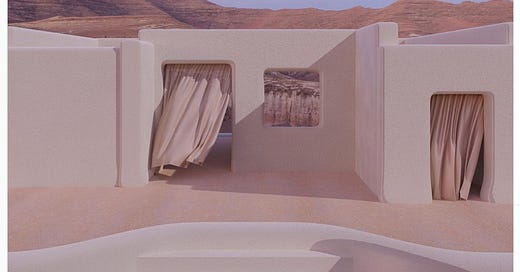Fool me twice
A former colleague of mine used to remind me, “Carine, no one reads. Make the copy shorter.” To my dismay, she was often right.
We’d run tests to see whether users understood the information presented. Often times, they wouldn’t understand, but in many of those cases, the answer was literally right in front of them on the screen. They had just glanced over the words.
Ironically, it’s often the most obvious things that we fail to notice.
Researchers call this "inattentional blindness”:
We consciously see only a small subset of our visual world, and when our attention is focused on one thing, we fail to notice other, unexpected things around us—including those we might want to see.

Image by Rebecca Lee.
While I’d love for this to be a beautiful hotel to add to my bucket list, it’s actually a digital rendering, a dreamscape of purple sunsets and warm wind. A girl can dream.
Fool me once
I was struck by this piece at the Hammer Museum.

Gala Porras-Kim. Photo: Hammer Museum.
It looks like some relic of a far away time and place, a hint of how someone once lived, preserved for future generations to piece together. The piece is embedded in ceramic and covered in a large plexiglass box that signals to the unworthy observer: “Don’t get too close. This is precious art, with a capital A-R-T.”
There’s even a letter signed by the Chief Curator and Museum Director to thank the artist for the donation.
And then I read the fine print, literally the writing on the wall:
Gala Porras-Kim reconstructs ancient artifacts that have no verifiable origins. Creating her own speculative histories for these orphaned objects, the artist teases out the flaws and contradictions within museum and collecting practices. For Reconstructed Southwest Artifact, Porras-Kim purchased what is purported to be a piece of ancient Southwestern pottery from eBay…
eBay?! Come on. You might as well tape a banana to the wall and call it art.
Fool me twice
And then, this.
I can’t stop thinking about an article I read this weekend by Jia Tolentino, who seems to have direct access to the inner thoughts of nearly everyone born in the 80s.
She was writing about “Instagram face,” a wild phenomenon in which women’s looks are converging into a single cyborgian vision of beauty — think high cheekbones, full lips, small nose, cat eyes. What started as a trend enabled by Instagram filters and photo editing apps is now moving into the real world with plastic surgery and fillers.
In other words:
A dozen or so people, mainly men, created Instagram
Then, they sold it for $1 billion to Facebook
Then, this innocuous visual platform combined forces with Facebook and birthed an entire ecosystem of aesthetically-minded people and companies. These people and companies are now known as influencers and brands
As these influencers and brands gained traction, algorithms favored their visual aesthetic. In turn, the platform began to redefine beautiful design for everything from brands to interior design
…[doo doo doo doo doo]…
Flash forward, and women are getting plastic surgery to make their faces look more like what algorithms dictate as beautiful
People make platforms. Then platforms make people.
In some ways, if you look at something again and again and again and don’t notice it, by the time you notice, there’s almost a shame in admitting you didn’t see it all along.
Climate change.
Checking our phones hundreds of times a day.
Giving random people at random companies access to deeply personal data.

Remember when we thought TV dinners were a good idea?
On a happier note
Listen: 9+ hours of good vibes (h/t @davidvivero)
Read: This newsletter by Sari Azout
Scroll through: The Daily Overview

“Jebel Kissu is a massif (a compact group of mountains) located in northwestern Sudan. It rises roughly 5,630 feet (1,716 m) above sea level, emerging abruptly like an island in the vast Sahara Desert. The bright linear features seen here are truck tracks — common in the Sahara where there are no paved roads.” Photo: Over-view.com


